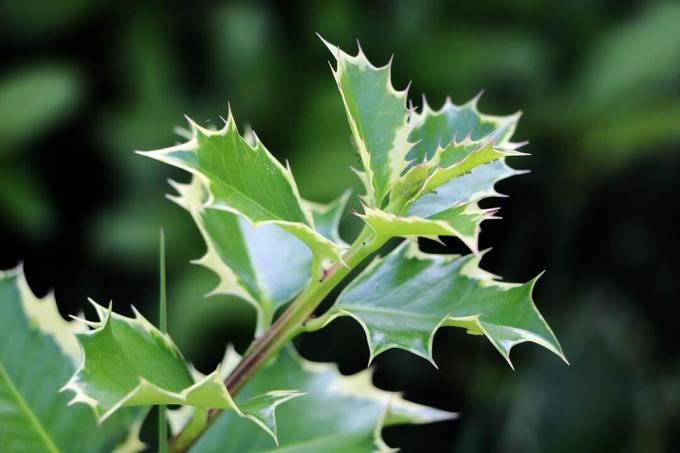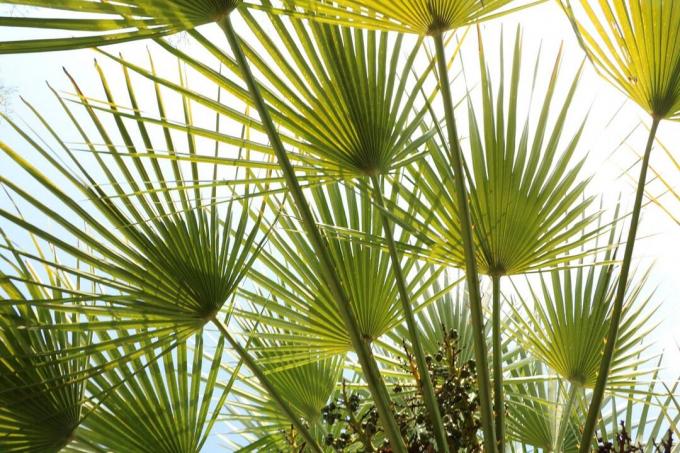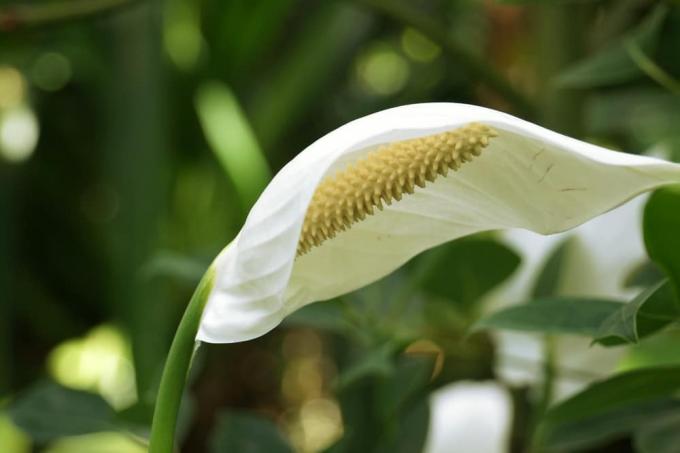

Table of contents
- Mountain palm (Chamaedorea elegans)
- Butia palm (Butia capitata)
- Kentia Palm (Howea)
- Coconut palm (Cocos nucifera)
- Coconut palm (Microcoelum weddelianum)
- Umbrella Palm (Livistona)
- High humidity
- waterlogging
- diseases and pests
- Conclusion
Palm trees are popularly referred to as the "princes of the plant kingdom". No doubt they are, whether they are short like the mountain palm, have fan-shaped leaves like the umbrella palm, or have pinnate foliage like the butia palm. Palm trees can be kept even in city apartments, where they refresh the atmosphere and noticeably emphasize the radiance of the interior. In addition to a bright location all day long, many palm trees also need good humidity. We introduce you to some easy-care palm trees for keeping indoors.
Mountain palm (Chamaedorea elegans)
The mountain palm is a widespread houseplant that adapts perfectly to living space conditions and can even flower in the room. It remains quite small compared to the other palms, although in its homeland in the mountain forests of Central America it can grow up to 5 m high as an undergrowth plant. The genus of mountain palms includes approx. 120 subspecies.
plant shape
- tubular, smooth trunk
- mostly pinnate leaves
- paniculate or simply branched yellow flowers
- Flowers look similar to mimosa flowers
- Flowers sit under or between the leaves
substrate
Mountain palms like to stand in permeable substrates that can even be slightly alkaline. This type of palm also tolerates slightly acidic soil.
Tip:
The mountain palm thrives and blooms best in hydroponics. However, the change should be made when the plant is still young. Later, their sensitive roots can be injured.
Location
Since mountain palms do not like full sun, they will take up even the shadiest spot in the home prefer, even if they prefer a bright location with a light irradiation of 700 lux would. In autumn and winter, the night temperatures at the site should not drop below 12 °C. Dry air does not harm her. However, a heavily heated room in winter has a detrimental effect on the mountain palm. In summer it can be given a shady spot outdoors.
watering and fertilizing
- water abundantly in summer
- keep the root ball very slightly moist in winter
- weekly liquid fertilizer in moderate concentration
- Fertilize from March to July
propagation
- by seeds at high soil temperatures between 24 and 26 °C
Butia palm (Butia capitata)
The butia palm originally comes from the South American continent. This feather palm species grows up to 5 m high there. It is also colloquially called jelly palm because delicious jelly can be prepared from its berries.
plant shape
- densely feathered, nicely curved fronds
- There are thorns at the base of a frond
- Remnants of dead palm fronds remain visible on the plant base
substrate
The Butia palm likes loamy potting soil and only needs to be repotted every four years.
Location
A bright, cool location all year round is best suited for the Butia capitata. In winter, the room temperature should not exceed 10 °C. For example, a little-used guest room or a cold conservatory are ideal.
watering and fertilizing
- likes moisture in the root area
- however, avoid waterlogging
- Fertilize every 4 weeks in summer
- with liquid fertilizer
propagation
- by sowing
- Germination time up to half a year
Kentia Palm (Howea)
The Kentia Palm, also commonly known as Howea, is a well-known, easy-care and quite slow-growing palm native to the Lord Howe Islands. There it can reach a height of 17 m. 100 years ago it was a real fashion palm. However, it has not lost any of its popularity to this day. It is a very desirable houseplant. There are two subspecies: Howea forsteriana (max. height 15 m) and Howea belmoreana (max. height 8 to 10 m).
plant shape
- spreading, especially Howea belmoreana
- elegant, slightly overhanging, feathered fronds
substrate
Both types of Kentia like well-drained substrates that can be slightly acidic. However, hydroponics is not desirable.
Location
The Kentia palm has few demands on humidity and light. It should stand a little away from the window, as it does not tolerate full sun exposure.
watering and fertilizing
- water sufficiently in summer
- less in winter
- Fertilize with compound fertilizer on moist soil
- March to July
propagation
- thrives when sown from fresh seed
- Germination sometimes takes up to 9 months
Coconut palm (Cocos nucifera)
The coconut palm is at home on all tropical sea coasts and is the most widespread crop. Almost all of their plant parts can be processed. At the age of 100 years, this feather palm can grow up to 30 m high in its homeland.
plant shape
- slender, brown trunk
- Trunk ends in a tuft of 20 to 30 feathers
- Feathers can grow up to 6 m long
- paniculate inflorescences
- Inflorescences arise from the leaf axils
substrate
The coconut palm requires well-drained substrate. For example, you can use garden soil and mix it with sand.
Location
The coconut palm loves warmth, but does not want blazing sun. A bright place all year round with summer temperatures around 20 °C is ideal. In winter, the temperature should be 15 to 18 °C. Like the other palms, it likes high humidity.
watering and fertilizing
- in summer it is watered abundantly
- In summer, fertilizer is used every 14 days
- water less in winter and do not fertilize
propagation
- by sowing
- only half of the coconut is used
- Place across the pot and keep moist and warm
- Germination time 4 to 6 months
Coconut palm (Microcoelum weddelianum)
The coconut tree was previously incorrectly assigned to the genus Cocos. The delicate feather palm comes from the tropics of Brazil, is only up to 1.5 m high and the trunk is only 3 cm thick.
plant shape
- fronds up to 1 m long
- leaflets located in pairs at the midrib
- blue-white color on the underside of the feathers
- Inflorescences produce orange-red fruits
substrate
The coconut tree also likes permeable substrate.
Location
Not in the blazing sun, but always set up brightly all year round. Ambient temperatures of 18 °C are ideal.
watering and fertilizing
- Always keep the substrate moist
- In summer, apply complete fertilizer every 3 weeks
propagation
- by sowing
- Germination time 2 months
Umbrella Palm (Livistona)
The Livistona is a beautiful fan palm. There are 24 species that come from Malaysia, Southeast Asia, New Guinea and Australia. However, 3 species are only suitable as houseplants: Livistona australis, Livistona chinensis and Livistona rotundifolia.
plant shape
- thorny stalks
- L australis and L. rotundifolia: round fans
- l. chinensis: elliptical fans
substrate
The substrate should be well drained. L rotundifolia likes sandy soil.
Location
The umbrella palm likes a light spot with moderate temperatures. In winter, temperatures between 14 and 18 °C are sufficient.
watering and fertilizing
- water regularly
- if the palm is warmer, water more
- limit watering in winter
- Fertilize every 14 days in summer
propagation
- by sowing
- Germination time up to 4 months
High humidity
Palm trees generally like high humidity. You can therefore regularly spray the palm fronds with soft water or gently wipe them with a damp cloth. At the same time you avoid an infestation with pests, especially in the winter months when the room air becomes drier due to heating. If your palm trees are not too big, they can be showered in the bathtub together with other indoor plants from time to time.
Tip:
If the palm trees cannot be offered sufficient humidity, the lack of moisture can be compensated for by a planter filled with water. However, the palm should not be constantly in the water!
waterlogging
Palm trees like high humidity and need a lot of water in summer. However, they do not tolerate waterlogging, as their roots can then rot very quickly!
diseases and pests
If the room air is too dry, spider mites, red spiders or mealybugs can settle on the fronds. The palms then also very quickly become unsightly and their frond tips yellowish or brown. However, with sufficient humidity of 40%, which is desired by almost all palm trees, you can prevent pest infestation. If you have discovered pests, you should use biological agents and not use aggressive chemical agents.
Conclusion
All of the palm species described can basically be cared for without much effort if you offer them a bright spot, with a few exceptions like the mountain palm. Palm trees do not like direct sunlight. If you water and fertilize the palm trees regularly, you will be able to enjoy these pretty creatures for a very long time. If you don't like liquid palm fertilizer or you find regular fertilization too time-consuming, you can use long-term fertilizer at the beginning of summer. The older fronds of the palm trees regularly die off. Therefore, they can cut these fronds without a twinge of conscience.
 garden editorial
garden editorial I write about everything that interests me in my garden.
Learn more about Exotic Plants

Holly, holly: care from A to Z
The European holly is one of the evergreen plants. It reaches a height of up to five meters and is ideal as a Christmas decoration or garden shrub. The native, although rarely occurring plant is the only native representative of the Ilex family and is particularly easy to care for and robust.

Dwarf palm, Chamaerops humilis: care instructions
The dwarf palm remains small enough that it can also be cared for in the room. However, it also cuts a fine figure in the garden. You can find out here how it is maintained and what needs to be considered.

Dwarf date palm, Phoenix roebelenii: Care from A-Z
The dwarf date palm (Phoenix roebelenii) is a particularly small, actually the smallest palm species of its genus. But that doesn't make them any less decorative. It is the most filigree and elegant date palm and hardly grows higher than one meter.

Growing vanilla plants: 11 tips for care
The vanilla plant is truly exotic in Central Europe and cannot be found in every garden. Vanilla planifolia forms the aromatic pods for which the plant is known. The cultivation of a vanilla plant is easily possible with the right care tips.

Kangaroo Paw: Caring for the kangaroo plant
Kangaroo paws are exotic plants native to southwestern Australia. Considering the care instructions, Kangaroo Paw can also thrive in Central European conditions. Maintenance requires a little more effort. If the plant gets enough attention, it will thank you with magnificent inflorescences.

Einblatt, Spathiphyllum: care from A to Z
Because of simple! The single sheet draws everyone's attention with its extravagant appearance. The imposing flower gives sophisticated rooms that certain something. If the houseplant is in the right place, hardly any care is required. The breeder can find out here what demands Spathiphyllum places on their location.

